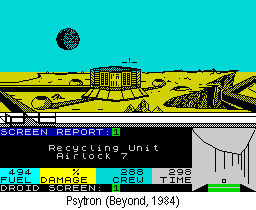|

By Lloyd Mangram
June
1984
Issue 5
|
|
Having
had his fill of page-compressed faces of alien monsters,
giant apes, famous detectives and evil warlocks, Oliver
broke out with this space action cover. No particular
game was in mind apart from the Defender / Scramble
concept, but the idea for a canyon constructed of game
cassettes was Roger Kean's. It was a typical situation
in the early days for Oliver to think up an idea, for
Roger, David or Matthew to rework it as a visual gag,
which Oliver would then implement so interestingly.
And this picture long remained a favourite with readers.
|
The cover slogan, The ONE BIG Spectrum Software MAG, wasn't
merely bombast, it was actually an aggressive parody of Big
K's logo. Big K was another example of a large corporation
(IPC) testing the software waters, in this case with a magazine,
but though it was a multiuser title, Big K’s prelaunch blurb
strode across preserves we at CRASH regarded as peculiarly
our own at the time, namely being irreverent about software
(though of course we also thought we were the only really
serious ones that's called having your cake and eating it).
When I look at the contents page of Issue Five, the thing
that strikes me now is that of all the sections competitions
was actually the biggest - seven DIYs - proving the point
that we recognised their popularity. But one of those competitions
stands out markedly, the Atic Atac map. Game maps were unheard
of in publications in 1984 - it simply hadn't occurred to
anyone that mapping a game was relevant, but there was no
doubt that some games being produced were actually made up
from maps in the programmers' minds. Atic Atac was one such,
and certainly one where having a map before you helped playing
it. There was also the fear that printing a game map might
upset the software house, for games stayed upon the shop shelves
far longer then than they do today. It was definitely a feather
in the CRASH cap to sign a competition deal with Ultimate,
for the magically successful software house was traditionally
uncommunicative with both public and press. Later, C&VG
editor Tim Metcalf even complained good-naturedly to Roger
Kean about the secret CRASH pipeline to Ultimate affection.
Maps were the latest thing; Issue Five saw the inaugural
edition of the Playing Tips. My desk was expanded and I began
regurgitating the erudite scribblings of readers who added
helpful hints to their letters. Among those had been primitive
Atic Atac maps, and one or two reasonable versions of Jet
Set Willy's terrifying mansion. The best, by Kenneth Kyle
from Notts, was avidly poured over by Roger Kean (who got
A level geography at school). He spent an entire weekend checking
it out against the game, using a handy infinite lives cheat
supplied by an embryonic hacker, and drawing up his own map
which then appeared in the issue, thanking Kenneth for his
inspiring version.
It started a trend; from this point on CRASH would have to
have maps whenever possible, and before long every other computer
mag dealing with games would follow suit. Otherwise the Playing
Tips seem pretty tame now, along the, 'from levels 17-24 of
Chuckie Egg, both the robot hens and the yellow hen
are after you. This increases the excitement and makes it
much harder' line. Thrilling.
 This
June issue was the real launch of Beyond, a powerful new software
house put together by EMAP, publishers of C&VG and Sinclair
User. Beyond's try-out game, Space Station Zebra, had
proved a dud, but Psytron was a Smash, largely because
of the complex, interlinked game elements and its use of crosshatched
graphics. The technique wasn't exactly new, but this was the
first time monochromatic line drawings had been used so extensively
on a plain-coloured background, providing a tremendously detailed
effect. This
June issue was the real launch of Beyond, a powerful new software
house put together by EMAP, publishers of C&VG and Sinclair
User. Beyond's try-out game, Space Station Zebra, had
proved a dud, but Psytron was a Smash, largely because
of the complex, interlinked game elements and its use of crosshatched
graphics. The technique wasn't exactly new, but this was the
first time monochromatic line drawings had been used so extensively
on a plain-coloured background, providing a tremendously detailed
effect.
Meanwhile, Derek's new Adventure Trail had also found a Smash
in Hewson's Fantasia Diamond. But at Psytron's release,
Beyond hinted that a revolutionary new adventure game, Lords
Of Midnight, was almost ready . . .
|